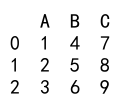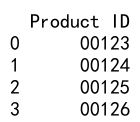Pandas astype String
Pandas is a powerful Python library used for data manipulation and analysis, particularly with tabular data. One common task in data processing is type conversion, where you might need to convert data from one type to another for various reasons such as data cleaning, preparation for analysis, or compatibility with other data formats or libraries. In this article, we will explore how to use the astype method in Pandas to convert data types to strings, which is often necessary when preparing data for output, storage, or further text-based processing.
Introduction to Pandas astype
The astype method in Pandas is used to cast a pandas object to a specified dtype. astype can be used to convert a single column or multiple columns of a DataFrame. When converting to a string, the method is straightforward and ensures that numeric or other types of data are converted into a string format, which can be crucial for tasks like exporting data to CSV or integrating with other Python libraries.
Example 1: Convert a Single Column to String
import pandas as pd
# Create a DataFrame
df = pd.DataFrame({
'A': [1, 2, 3],
'B': [4, 5, 6]
})
# Convert column 'A' to string
df['A'] = df['A'].astype(str)
print(df)
Output:

Example 2: Convert Multiple Columns to String
import pandas as pd
# Create a DataFrame
df = pd.DataFrame({
'A': [1, 2, 3],
'B': [4, 5, 6],
'C': [7, 8, 9]
})
# Convert columns 'A' and 'B' to string
df[['A', 'B']] = df[['A', 'B']].astype(str)
print(df)
Output:

Handling Mixed Types
Sometimes, data columns may contain mixed types, such as integers, floats, and missing values. Converting mixed-type columns to strings can be slightly more complex, as you need to ensure that all types are handled correctly.
Example 3: Convert Mixed Type Column to String
import pandas as pd
# Create a DataFrame with mixed types
df = pd.DataFrame({
'A': [1, '2', None, 4.0]
})
# Convert column 'A' to string
df['A'] = df['A'].astype(str)
print(df)
Output:

Advanced String Operations
After converting columns to strings, you might want to perform more complex operations such as string manipulation or pattern matching. Pandas provides a host of string methods that can be applied directly to Series and DataFrame objects.
Example 4: String Manipulation After Type Conversion
import pandas as pd
# Create a DataFrame
df = pd.DataFrame({
'URL': ['pandasdataframe.com/1', 'pandasdataframe.com/2', 'pandasdataframe.com/3']
})
# Convert 'URL' to string and split by '/'
df['URL'] = df['URL'].astype(str)
df['Split URL'] = df['URL'].apply(lambda x: x.split('/'))
print(df)
Output:

Example 5: Using String Methods
import pandas as pd
# Create a DataFrame
df = pd.DataFrame({
'Email': ['[email protected]', '[email protected]', '[email protected]']
})
# Convert 'Email' to string and apply a string method
df['Email'] = df['Email'].astype(str)
df['Domain'] = df['Email'].apply(lambda x: x.split('@')[1])
print(df)
Output:

Practical Applications
Converting data types to strings is not just a theoretical exercise; it has practical applications in data science, particularly in data cleaning and preparation.
Example 6: Cleaning Data
import pandas as pd
# Create a DataFrame with inconsistent data types
df = pd.DataFrame({
'Product ID': [123, '00124', 125, '00126']
})
# Standardize 'Product ID' as string
df['Product ID'] = df['Product ID'].astype(str)
df['Product ID'] = df['Product ID'].apply(lambda x: x.zfill(5))
print(df)
Output:

Example 7: Preparing Data for Export
import pandas as pd
# Create a DataFrame
df = pd.DataFrame({
'Date': [20230101, 20230102, 20230103],
'Value': [100, 200, 300]
})
# Convert 'Date' to string for CSV export
df['Date'] = df['Date'].astype(str)
print(df)
Output:

Pandas astype String Conclusion
Converting data types to strings using the astype method in Pandas is a fundamental skill in data manipulation. It allows for more flexible data handling and prepares data for various outputs and further processing. Whether you are cleaning data, preparing it for analysis, or exporting it to other formats, understanding how to effectively convert data types, especially to strings, is crucial in ensuring the integrity and usability of your data.
In this article, we’ve covered the basics of using astype to convert data types to strings, handling mixed types, and applying advanced string operations. These skills are essential for any data scientist or analyst working with Python and Pandas.
 Pandas Dataframe
Pandas Dataframe